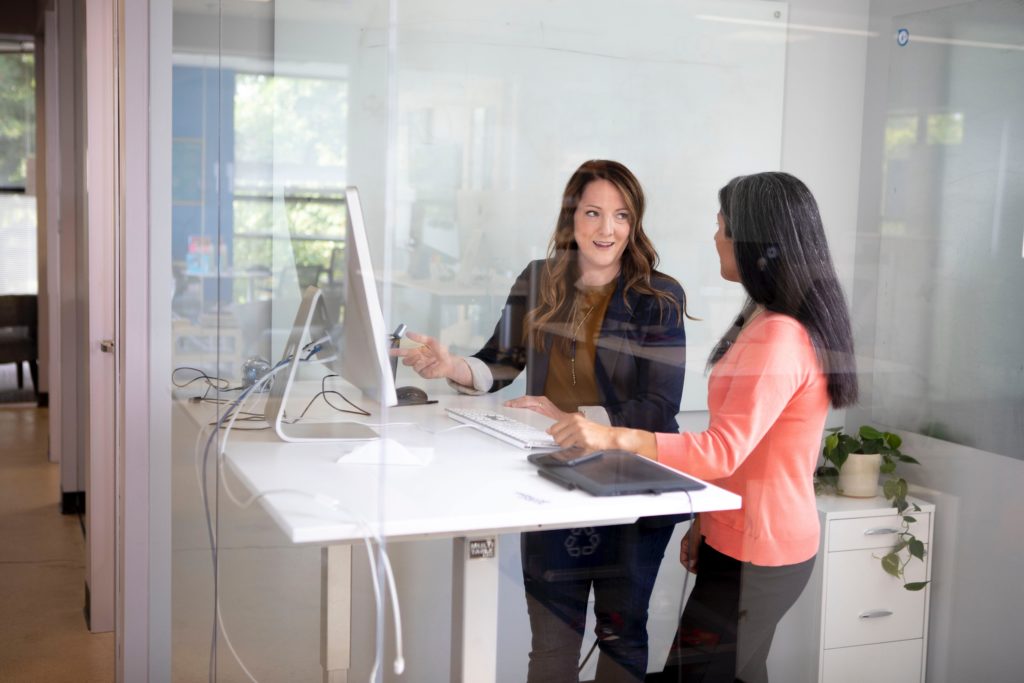WORK MORE EASILY THROUGH LIGHT MOVEMENT

Chiara is convinced that we would be better off if the working world allowed more freedom of movement – and even consults Nietzsche for this.
Working people know what it’s like: meetings that go on forever, inner restlessness, and ever-dwindling concentration. Meetings in which you eventually start to slide back and forth on the chair and your lumbar spine slowly but surely starts to feel uncomfortable. If only you could stretch or stand up for a moment. But what does that look like? What would the supervisors think?
Why is the modern working world so fixated on sitting?
Being able to sit comfortably is an achievement that is well deserved. Thanks to technical progress and industrialization, most people today can sit at work, and fewer and fewer jobs in Germany require physical exertion. Therefore, very few people have a body that has been steeled by their job.
Yes, we like to make ourselves comfortable and literally sit out one or two problems. When we enter the education system, the course for our sitting career is set early on: Those who can sit still get into less trouble at school. Those who always sit down properly and study are rewarded with good report cards. Those who are particularly persistent and committed at work will one day get the comfortable boss’s chair – or the academic chair. Sitting is more than just a cherished habit. It is a behavior that conforms to standards and is expected of us.
Creative people stand wiser
Friedrich Nietzsche already stated that one should “not believe any thought that was not born in the open air and free movement. In ancient Greece, the Peripatetics, Aristotle’s walking philosophy students, also gained knowledge by walking around.
In the creative industry, the potential of movement at work has long been recognized (have they all read Nietzsche?). Innovations are developed using methods such as design thinking, for example, in which people stand and walk around naturally during the work process. Rumor has it that hip companies have even set up “creation rooms” instead of “boardrooms.”
Freedom of movement helps us let thoughts flow. And at the same time, an upright posture also helps us to better represent and express our inner attitude. We just adopt it far too rarely.
Sitting is a silent killer
Few people know that sitting not only makes the body and mind sluggish but also poses a serious health risk. Because what seems so harmless and safe – what could possibly happen to you sitting on the latest ergonomic office chair? – can cause us a whole host of problems, from diabetes and cardiovascular disease to colon cancer and depression. Even if you exercise regularly after work, you can only compensate to a limited extent for the risks you „gain“ sitting during the day.
To be more precise, you have to do one hour of exercise every day to compensate for 8 hours of sitting every day. To me, that sounds like a bad deal. Why should I push myself around in a chair all day to then run to the gym every evening with a guilty conscience? Wouldn’t it be much smarter to shake up the existing sitting norms and make the workday a little more agile? Of course, this doesn’t mean that sports are superfluous, but 2.5 hours of moderate-intensity activity or 75 minutes of high-intensity exercise per week is enough to promote and maintain health in a lightly moving office routine. I find that much more realistic.
Work and study everyday life standing and in motion.



Stand-Up-Meetings at TRANSFER TOGETHER
In the transfer project, I deal with the question of how to give the “mind” enough exercise and, at the same time, do something good for one’s health. How can work succeed without sitting all the time? At TRANSFER TOGETHER we live a new movement friendliness. We meet for stand-up meetings (it’s wonderful how quickly everyone gets to the point), we can get up in between meetings whenever we feel like it, and when the weather is good, we simply go outside with our work documents. We would like to bring this new and at the same time ancient (see Nietzsche and the Peripatetics) way of working into the corporate world with our project “Leicht bewegt”.
What does your everyday working life look like? Are you already “easily moved” or are you still sitting? And what do you think it takes to bring movement into meetings?
With these questions, I leave to the next team meeting. Fortunately, I don’t have to sit there.

Chiara Dold
Chiara brings movement into the office: she is developing a web-based toolkit that helps companies integrate light physical activity into their daily work routine. Go to Chiara’s project page and the project Kopfstehen
